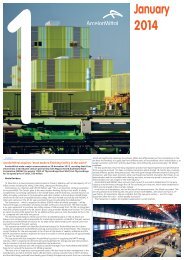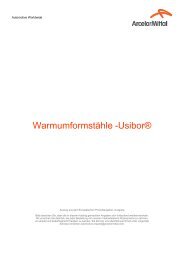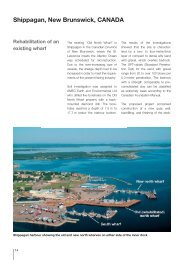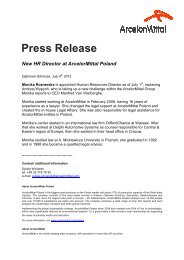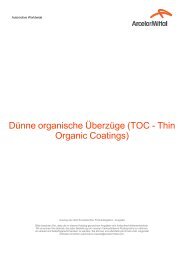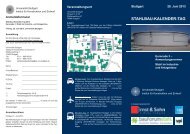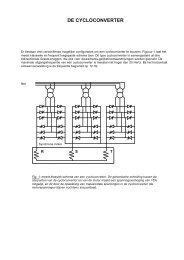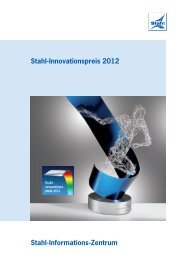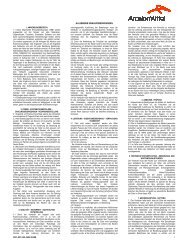ArcelorMittal Annual Report 2008
ArcelorMittal Annual Report 2008
ArcelorMittal Annual Report 2008
You also want an ePaper? Increase the reach of your titles
YUMPU automatically turns print PDFs into web optimized ePapers that Google loves.
<strong>ArcelorMittal</strong> has provided for all<br />
receivables over 180 days because<br />
historical experience is such that<br />
receivables that are past due beyond<br />
180 days are generally not recoverable.<br />
Trade receivables between 60 days and<br />
180 days are provided for based on<br />
estimated irrecoverable amounts from the<br />
sale of goods and/or services, determined<br />
by reference to past default experience.<br />
Inventories<br />
Inventories are carried at the lower of<br />
cost and net realizable value. Cost is<br />
determined using the first-in, first-out<br />
(“FIFO”) method or average cost method,<br />
which approximates FIFO. Costs of<br />
production in process and finished goods<br />
include the purchase costs of raw materials<br />
and conversion costs such as direct labor<br />
and an allocation of fixed and variable<br />
production overheads. Raw materials and<br />
spare parts are valued at cost inclusive<br />
of freight and shipping and handling costs.<br />
Net realizable value represents the<br />
estimated selling price at which the<br />
inventories can be realized in the normal<br />
course of business after allowing for the<br />
cost of conversion from their existing state<br />
to a finished condition and for the cost<br />
of marketing, selling, and distribution.<br />
Goodwill and negative goodwill<br />
Goodwill arising on an acquisition<br />
is recognized as an asset and initially<br />
measured at cost, being the excess of<br />
the cost of the business combination<br />
over <strong>ArcelorMittal</strong>’s interest in the net fair<br />
value of the identifiable assets, liabilities<br />
and contingent liabilities recognized.<br />
Goodwill is allocated to the<br />
cash-generating units expected to<br />
benefit from the synergies of the<br />
combination for the purpose of impairment<br />
testing. The allocation is made to those<br />
cash-generating units or groups of<br />
cash-generating units that are expected<br />
to benefit from the business combination<br />
in which the goodwill arose.<br />
Goodwill is reviewed at the<br />
cash-generating unit level for<br />
impairment annually or whenever<br />
changes in circumstances indicate that the<br />
carrying amount may not be recoverable.<br />
The recoverable amounts of the<br />
cash-generating units are determined<br />
from the higher of fair value less cost<br />
to sell or value in use calculations,<br />
as described in the impairment of tangible<br />
and intangible assets. The key assumptions<br />
for the value in use calculations are those<br />
regarding the discount rates, growth rates<br />
and expected changes to selling prices<br />
and direct costs during the period.<br />
Management estimates discount rates<br />
using pre-tax rates that reflect current<br />
market rates for investments of similar risk.<br />
The growth rates are based on the<br />
Company’s growth forecasts which are<br />
in line with industry trends. Changes in<br />
selling prices and direct costs are based<br />
on historical experience and expectations<br />
of future changes in the market.<br />
Cash flow forecasts are derived from the<br />
most recent financial forecasts for the<br />
next five years. Beyond the specifically<br />
forecasted period, the Company<br />
extrapolates cash flows for the remaining<br />
years based on an estimated growth rate.<br />
This rate does not exceed the average<br />
long-term growth rate for the relevant<br />
markets. Once recognized, impairment<br />
losses recognized for goodwill are not<br />
reversed. On disposal of a subsidiary,<br />
any residual amount of goodwill is included<br />
in the determination of the profit or loss<br />
on disposal.<br />
<strong>ArcelorMittal</strong> has historically purchased<br />
certain steel assets involved in various<br />
privatization programs in former<br />
government controlled economies.<br />
Businesses with these characteristics<br />
typically have been purchased for<br />
an amount that does not exceed net asset<br />
fair value, thus producing negative goodwill<br />
for accounting purposes.<br />
In a business combination in which<br />
the fair value of the identifiable net<br />
assets acquired exceeds the cost of the<br />
acquired business, the Company reassesses<br />
the fair value of the assets acquired.<br />
If, after reassessment, <strong>ArcelorMittal</strong>’s<br />
interest in the net fair value of the<br />
acquiree’s identifiable assets, liabilities<br />
and contingent liabilities exceeds the<br />
cost of the business combination,<br />
the excess (negative goodwill) is<br />
recognized immediately in the<br />
statement of income.<br />
Intangible assets<br />
Intangible assets are recognized only<br />
when it is probable that the expected<br />
future economic benefits attributable<br />
to the assets will accrue to the Company<br />
and the cost can be reliably measured.<br />
Intangible assets acquired separately<br />
by <strong>ArcelorMittal</strong> are initially recorded<br />
at cost and those acquired in a business<br />
combination are recorded at fair value.<br />
These primarily include the cost of<br />
technology and licenses purchased<br />
from third parties. Intangible assets are<br />
amortized on a straight-line basis over<br />
their estimated economic useful lives<br />
which typically are not to exceed five years.<br />
Costs incurred on internally developed<br />
products are recognized as intangible<br />
assets from the date that all of the<br />
following conditions are met: (i) completion<br />
of the development is considered<br />
technically feasible and commercially viable;<br />
(ii) it is the intention and ability of the<br />
Company to complete the intangible asset<br />
and use or sell it; (iii) it is probable that the<br />
intangible asset will generate future<br />
economic benefits; (iv) adequate technical,<br />
financial, and other resources to complete<br />
the development and to use or sell the<br />
intangible asset are available; and (v) it is<br />
possible to reliably measure the expenditure<br />
attributable to the intangible asset during<br />
its development.<br />
85<br />
<strong>2008</strong> Consolidated Financial Statements continued<br />
<strong>ArcelorMittal</strong> <strong>Annual</strong> <strong>Report</strong> <strong>2008</strong>



